Already in 2014, after obtaining the SEO Guru certificate, I published a guide, in English, for the best SEO techniques (website optimization to appear at the top of search engines), both On Page and Off Page. Even today, after almost 6 years, that page is the most visited on my site. I therefore decided, given the interest of readers, to publish two more articles on SEO, dividing the contents in this way:

- best On Page SEO techniques;
- best Off Page SEO techniques.
I recognize that the topic of SEO is quite controversial. On the other hand, thanks to the experience of managing various company sites (as well as this personal one), I can affirm that some techniques are always effective and impactful, despite the passage of time.
In this article, list the best SEO techniques (Search Engine Optimization), the ones I prefer and apply, On Page: are optimization techniques that apply to the text and images of the page, as well as hosting the website. Using these techniques, your page will arrive naturally (or organically, as some prefer to say) on the first page of the search engine, without any need for paid advertisements.
For example, try typing my first and last name on Google, Yahoo or Bing and you'll see what I mean.

In a subsequent article I will describe the SEO Off Page strategies, that is, that are not related to the text of the page, as they apply to websites external to your own.

Best On Page SEO Techniques
1) Yoast SEO on WordPress sites
If you are using WordPress To manage the website, it is advisable to install the free plugin Yoast SEO. It's a rather complete plugin, which helps you follow some of the strategies I'm about to list. It also allows automatic management of the SiteMap of the website.
In the Yoast SEO plugin there is also a text readability indicator, which helps to simplify the sentences of the text of the web page. In this way, the page will be more readable even by non-expert users.
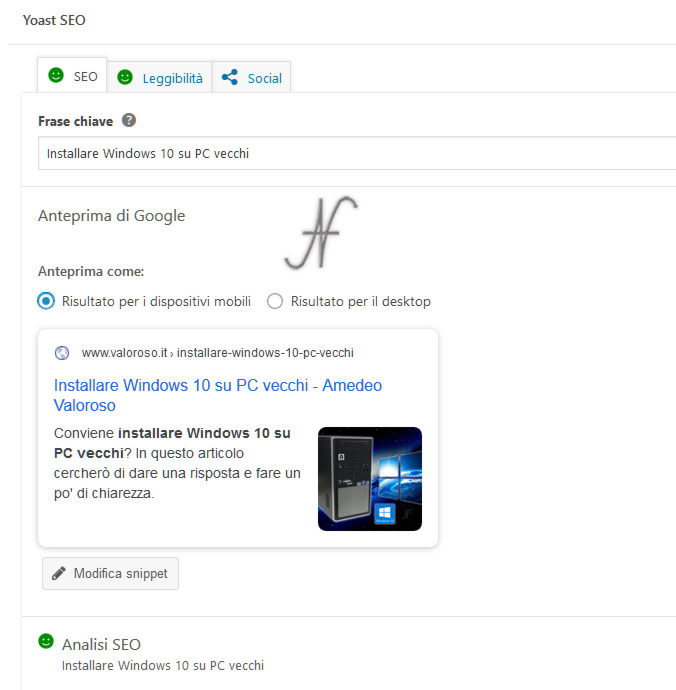
2) Use a responsive theme
It is now official that search engines prefer articles written so that users can also read them from their mobile phones. For those who use WordPress, or even a similar CMS, it is now a must to install a theme that is responsive, that is, one that adapts to the shape of the computer, smartphone and tablet monitor.
3) Find the keywords before writing the article text
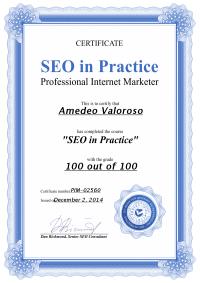 Before! Before writing the text! You need to identify the topic of the text and think of some words that describe it naturally. The choice of keywords is fundamental.
Before! Before writing the text! You need to identify the topic of the text and think of some words that describe it naturally. The choice of keywords is fundamental.

For some time now we have been hearing about keyphrases (key phrase), just to indicate that the keyword must not be single. Instead, choose a sentence of two or three words.
The key phrase must be relevant to the text, but to think about it, you need to put yourself in the reader's shoes. What would the reader write on Google when he wants to find the topic described on our page?
Another question to ask is the following: who do we want our page to be addressed to? To all users or just those in our area?
Some examples of key phrases I have used on my websites are the following:
- data logger jet grouting
- Malpensa furnished offices
- Cairate home automation
Trying these keywords on Google, at the top (after paid ads) are the sites of the businesses I manage (DAT instruments, OfficeNow and Control Casa).
For keyword research, it can be convenient to Keyword Planner di Google, although you'll need to open a Google Ads account (even without paying for ads) to use it.
It also finds synonyms for keywords
It is good to find synonyms and variations of keywords. If you plan to write multiple articles on the same topic, change the key phrase for each article. Don't always use the same one.
If, on the other hand, you do not have other articles on the same topic, you can use synonyms and variations of the key phrase within the single article.
4) Write text for people, but optimize it for search engines
There are those who say that text must be written in a natural way, for people, while others argue that it must be written in a way that makes it understandable to search engines. But who is right? Everyone!
The text (also called copy) should be written in a natural way, understandable to the people who read. The minimum length of text to be written is 280-300 words. On the contrary, if the text becomes too long, it may be convenient to divide it into two different articles, each with different keywords.
Furthermore, the key phrase must be included several times, in a natural way, within the text, as well as the titles. The phrase should not be artificially repeated endlessly: this would be penalised.
There is a parameter, the keyword density, which describes, as a percentage, the Number of repetitions of the keyword (or keyphrase) in the text, compared to the length (number of words) of the text itself. Having the keyword density = 0 means not having included the keyword in the text, which is obviously wrong. On the contrary, having too high a keyword density (>10%) can still penalize the indexing of the page by search engines.

In addition to Yoast SEO for WordPress, previously described, there are other online tools to evaluate the keyword density that we have used in the text, for example:
In addition to analyzing the texts we produce, to see how search engines interpret them, these tools can be useful to analyze the pages of competitors and take some ideas on the keywords they use.
A suggestion. Among the keywords found by the tools indicated above, there may be prepositions and articles: do not pay attention to them.
5) Write original text, don't copy/paste
Search engines penalize the copy / paste of texts between the various websites. Instead, they promote original content. The same goes for photos: try to use original images and, maybe, a little Photoshop to make some eye-catching collages.
There are tools to check if the text of the article, or even part of it, is the result of copy/paste. Here are a couple:
6) Insert images
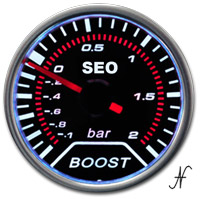 Insert relevant images into the article you are writing. Recently, the layout of the pages has changed to be more accessible to mobile devices, so blocks of text are used, alternating with full-width images. For example, the image on the side like this one that I inserted (BOOST) was used a few years ago. Today we prefer to use full-width images, like the one inserted in the next paragraph.
Insert relevant images into the article you are writing. Recently, the layout of the pages has changed to be more accessible to mobile devices, so blocks of text are used, alternating with full-width images. For example, the image on the side like this one that I inserted (BOOST) was used a few years ago. Today we prefer to use full-width images, like the one inserted in the next paragraph.
Image file names should briefly describe the contents of the image. In some images, the file name must also contain keywords.
Nomi dei file come "Foto0001.jpg" devono essere evitati. Meglio quindi rinominare le foto con nomi più descrittivi, tipo "negozio-riparazione-computer-Varese.jpg".

Photos should be optimized to take up as little space as possible to make the page load faster. You have to reduce the size of the photo, but not so much as to degrade its quality.
7) Use alternative text of images
Images... they must be images! You should not write long texts in photographs, as they would not be indexed by search engines. Each text-relevant image (not purely decorative ones) must contain descriptive text in the alt text attribute. The alternative text of the images, those most relevant to the topic, must also contain the keywords.
Example:
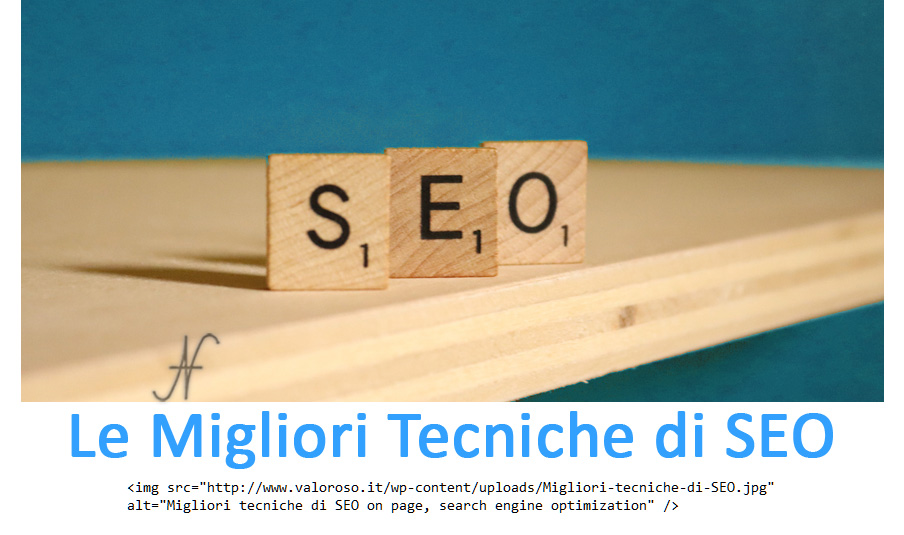
8) The page URL must be descriptive
The address of the page (the URL or the permalink, whatever you want to call it) must describe briefly The content and must also include keywords. For example,:
www.ilmiosito.it/migliori-tecniche-SEO
9) Enter the tags TITLE and META DESCRIPTION
This operation is much easier if you work in WordPress with the Yoast SEO plugin. However, you can also insert these tags into static html web pages. Both the title and meta description must contain keywords.
The title length must be between 40 and 70 characters, and the length of the meta description must be between 120 and 150 characters.
<head> ... <title>datarecorder.eu - Datalogger internal components</title> <meta name="description" content="DAT instruments, datalogger design guide. Signals from sensor to converter, from CPU to memory and to computer. Analog and digital values."> ... ... </head>
Both the title and the meta description are shown in Google search results.

10) Write the company address on the contact page in the footer of the website
It's right to create one contact page on the website. In this way, users will be able to easily know where we are, find our references and even send a message.

Equally important, to improve your ranking on search engines on local searches, you use this On Page SEO technique: write the address, and any other contacts, in the footer of the website. The footer is the bottom part of the site, which always remains the same regardless of the page of the site you are viewing.
11) Try to fix HTML errors
As far as possible (particularly if you are not using a CMS like WordPress), it is a good idea to avoid errors in the HTML of the page. This online tool can help check any errors on web pages: validator.w3.org.
12) Avoid broken links
When writing an article, links can be inserted that point to pages inside the site or even external. Periodically, check that the links are still all active. If there are links that no longer work, it is good to remove or correct them. Search engines penalize pages with links that no longer work, in fact they may feel that the content is now obsolete.
A good tool to check if there are broken links on the website is the following: www.brokenlinkcheck.com/broken-links.php.
13) The web page must not look like spam to search engines
Search engines mainly consider the text on the page. The text is present in the title, in the URL, in the body of the page, in the alternative text of images, in links, etc...
But how do search engines see the page? With this tool you can see the text as a search engine would see it: adresults.nl/tools/lynx-viewer. (The site starts in Dutch, but there is also the English flag at the top!)
Especially if you use CMS such as WordPress or others, some plugins may insert hidden links. With this tool you can unmask them!
14) Check the Robots.txt file and the SiteMap XML of the site
The file Robots.txt contains instructions for search engines. Inside the file Robots.txt It is necessary to indicate the paths in which search engines must not enter. For example, I have indicated some paths related to WordPress, but that have nothing to do with my articles.

In addition inside the file Robots.txt, you must indicate the location of the XML SiteMaps, which can be created automatically by the Yoast SEO plugin and which contain the list of paths to the pages, articles and images of the site.
User-agent: *
Sitemap: http://www.ilmiosito.com/en/sitemap_index.xml
Sitemap: http://www.ilmiosito.com/sitemap_index.xml
Disallow: /wp-admin/
Disallow: /wp-includes/
Disallow: /wp-content/plugins
Disallow: /wp-content/themes
It is not enough for articles, pages or images to be present in the SiteMap to be indexed by the search engine: it is necessary for a link (internal or external to the site), or a menu, to point to the various articles and pages. Furthermore, images must be used within the pages to be indexed.
To submit your sitemap to major search engines, such as Google, you must create a account webmaster, prove ownership of the website and declare the location of the SiteMap.
15) Among the best techniques of SEO On Page, you can not miss a fast and reliable website
Website speed optimization
No one wants to wait long for a web page to load. Already 3 seconds of loading can be too much!
It is therefore necessary to also use these On Page SEO techniques:
- reduce redirects;
- avoid HTTP requests to non-existent pages or media;
- enable the use of browser cache;
- use compression;
- minimize the size of the images, while maintaining good quality.
To make some of these settings, you must have access to the file .htaccess of the website.
A good tool that helps to identify any anomalies is the following: tools.pingdom.com.
I recommend testing the loading speed, initially at least of the homepage of the site, and correct any problems.

Web hosting service
To make the site fast and reliable, you have to choose a really reliable and fast hosting service. The features to focus on are:
- unlimited traffic;
- high bandwidth;
- guarantee of uptime of at least 99.5%;
- high server speed (better a dedicated, multiprocessor server);
- server located in Italy or Europe;
- technical assistance;
- website statistics;
- better to choose a plan with a dedicated IP address.
Along with the other On Page SEO strategies listed above, having a good hosting service will help improve your search engine rankings.
16) Periodically check the statistics of the site
Both the web hosting service provider, as well as some WordPress plugins, can provide interesting statistics on visits to the website.
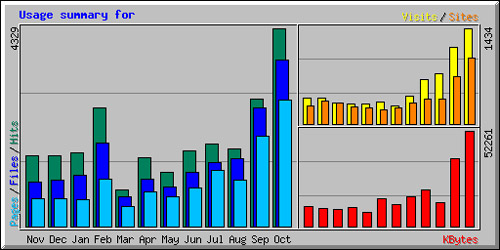
The example above shows the graph returned by Webalizer, which directly analyzes the logs of requests received by the server. There are several important parameters to consider:
- SITES: is the number of unique IP addresses (unique hostnames) that sent requests to the server. It is a data that represents the number of unique visitors to the website (across all pages), in the indicated period.
- VISITS: is the number of visits that the site has received on the various pages (from different users or even from the same user).
- PAGES: Represents the number of pages on the site that have been visited.
To better analyze the statistics, I recommend combining some parameters with each other (calculate the ratio between the two quantities):
- Pages/Visits: how many pages of the site, on average, a user viewed in a single visit.
- Visits/Sites: how many visits made, on average, each individual user to the website (in the period indicated).
- Pages/Sites: number of pages visited, on average, by the same user in the period indicated.
I recommend sifting through the various options offered by the programs that generate statistics. For example, it is interesting to know which pages of the site are most appreciated.
17) Use an SSL certificate to switch from HTTP to HTTPS
Some suggest switching to HTTPS to improve search engine rankings. There are different types of SSL certificate: the important thing is to choose one from a reliable provider. It is not permitted, except for experimental purposes, to generate certificates independently.
In some hosting services, the SSL certificate is included. Alternatively, you can evaluate the free certificates of Let's Encrypt.

Have these On Page SEO strategies been useful to you?
I hope you enjoyed this article. I know that many propose 50, 100 or more SEO strategies, but, I assure you, already correctly apply at least 13 of those I have proposed, it will be a great success for your site!
Probably, for superstition, some just will not want to apply all 17 strategies.


It's hard to find well-informed people on this topic, but you seem to know what you're talking about! Thank you!